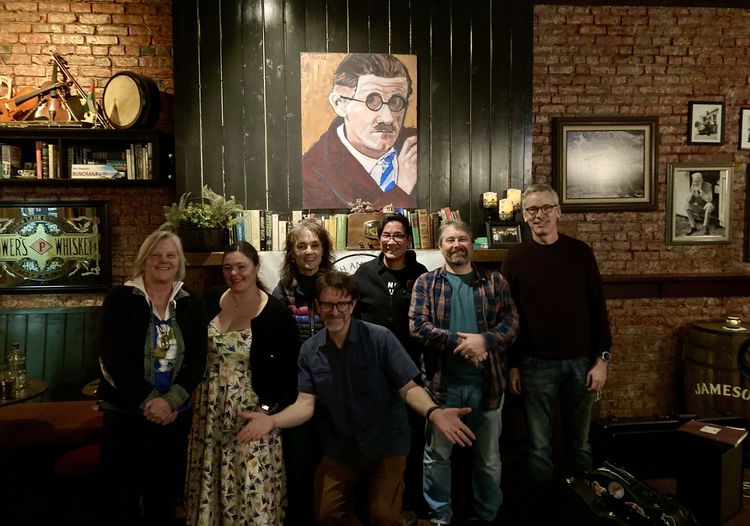Sue Hubbard’s latest novel “Rainsongs” has just been published in the U.S.
PHOTO COURTESY OF THE AUTHOR
Page Turner / Edited by Peter McDermott
“‘Rainsongs’ is a novel about my abiding themes: love, loss and redemption,” writer Sue Hubbard told us when asked, “It is strongly rooted in a sense of place, the far west coast of Ireland on the edge of Europe. Being on the edge is both actual and metaphorical.”
And she added, intriguingly, that the book has a twin backdrop: “Virginia Woolf's ‘To the Lighthouse’ and the life of the 6th-century monks on the Skelligs.”
Hubbard offers an elaboration of this in a video on her website. When she first visited the Kerry coast, she says, the ancient landscape “really penetrated my consciousness, as did many of the people who were living there.” She adds about the two islands just 13 kilometers away, which in her view should be included in an updated Seven Wonders of the World: “The Skelligs became for me the place we all long for in exactly the same way that Virginia Woolf’s Lighthouse is.”
Hubbard told the Echo that her novel “addresses themes of longing and disappointment and how we find healing though landscape and in the hidden recesses of ourselves.
“All this is set against the backdrop of the Celtic Tiger and explores the struggle between an encroaching modernity and a traditional way of life.”
At the outset in “Rainsongs,” it’s Dec. 29, 2007, and the protagonist Martha Cassidy travels to the remote cottage that her recently deceased husband, Brendan, used as a retreat from the world and a place to write.
“To the few in London who enquired, she said she was coming over to Kerry to sort out his affairs. And the truth? Well, she’s not sure. Maybe she’s simply come back to make sense of all that she was unable to attend to during those 30 odd years, with their brief joys and substantial griefs that turned out to be their lives.”
Foremost in the latter category is the death of their 10-year-old son Bruno, two decades before.
In the ensuing winter days, Martha is drawn into a standoff between Paddy O’Connell, an elderly hill farmer, and successful hotel entrepreneur Eugene Riordan, and through that she meets a talented young poet and musician, Colm.
Hubbard’s own poetry has been read on BBC Radio 3 and Radio 4, while her poem “Eurydice” – London’s largest public art poem – stretches across Waterloo station. That work and her novels have won numerous awards and prizes over the last few decades, as well as attracting admiration from some iconic writers along the way.
John Berger, for example, wrote that “Depth of Field,” a previous novel, had “the rare quality, not of a text but of a place. It surrounds its readers and waits until they see in the dark and make their own discoveries.”
And Fay Weldon said of another, “‘Girl in White’ is a triumph of literary and artistic understanding, a tour du force: masterly, moving.
“Hubbard goes where few dare go,” Weldon continued, “and succeeds. You are the less for not reading it.”
The American Library Association’s Booklist said of her latest: “For her keen and gracious insights into the relentless grieving process, for her transcendent evocation of the rough charm and enduring splendor of Ireland’s rural treasures, Hubbard deserves a place in the literary pantheon near Colm Tóibín, Anne Enright, and William Trevor.”
The Irish Times’ reviewer said: “Hubbard’s precise descriptions of the physical landscape are tremendous and moving. There is a real sense of Kerry here, and Martha’s empathy with Irish people past and present permeates her solitary adventure.”
Writer and journalist Eleanor Fitzsimons said: “A lyrical evocation of Ireland's fragile, ancient coastline reveals a poet's sensibility. This multi-layered story of love and loss, of a woman 'erased by grief,' who finds solace in the heart of a community that is threatened from within, is exceptionally moving. This book will stay with you.”

Sue Hubbard
Date of birth: March 30
Place of birth: London
Spouse: Divorced
Children: 3
Residence: London
Published works: “Rainsongs” (The Overlook Press); “Depth of Field” (Dewi Lewis); “Rothko’s Red” (Salt); “Girl in White” (Cinnamon Press). Poetry: “Everything Begins With the Skin” (Enitharmon) Collection; “Oxford Poets 2000” (Carcanet) Anthology; Ghost Station (Salt) Collection; The Idea of Islands (Occasional Press) collaboration with Irish artist Donald Teskey; “The Forgetting and Remembering of Air (Salt) Collection; Art: “Adventures in Art: selected essays 1990-2000” – (Damien Hirst’s Other Criteria)
What is your writing routine? Are there ideal conditions?
Stressful and chaotic because I am also an arts journalist with tight deadlines. I tend to go away to remote places for quiet and concentration, on residencies or to friends in the country for periods to write fiction and poetry
What advice do you have for aspiring writers?
It’s tough. Don’t do it unless you really want to. Nothing is guaranteed. But if you do want to read, read, read and edit, edit, edit. Develop your own voice. Be authentic. Not fashionable
Name three books that are memorable in terms of your reading pleasure.
“Golden Note Book,” by Doris Lessing; “Any Human Heart,” by William Boyd; “American Pastoral,” by Philip Roth.
What book are you currently reading?
“My Name is Lucy Barton” by Elizabeth Strout.
Is there a book you wish you had written?
“The English Patient,” by Michael Ondaajte.
If you could meet one author, living or dead, who would it be?
Virginia Woolf.
What book changed your life?
Different books at different times: “Memoires of a Dutiful Daughter,” by Simone de Beauvoir. “Austerlitz,” by W.G. Sebald. “Wuthering Heights,” by Emily Bronte; “Jude the Obscure,” by Thomas Hardy.
What is your favorite spot in Ireland?
St. Finnian’s Bay facing the Skelligs.
You're Irish if...
I am not Irish. I am English. I just fell in love with the place. It has fed me creatively.









